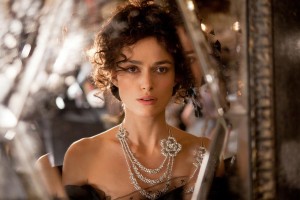Karenina dazzles with visual spectacle
If literature has proven one thing over and over again, it’s that love is epic, beautiful and, more than anything else, tragic. Whether it’s Romeo losing his Juliet, Odysseus sailing away from Penelope or Elizabeth Bennett’s prejudices against Mr. Darcy, great romances always come at a price.

Period piece · Keira Knightly stars as the titular character in Joe Wright’s adaptation of the Leo Tolstoy novel Anna Karenina, which follows the love triangle between an aristocrat, her young lover and her watchful husband. – | Photo by Laurie Sparham, courtesy of Focus Features
Anna Karenina is the latest film adaptation of one of these great love stories, based on world-renowned Russian author Leo Tolstoy’s 800-page novel of the same name. There have been several movies based on the book, but this year’s version (directed by Joe Wright) proves to be the boldest vision of them all: The way and style in which the story is told is much more important and resonating than the story itself.
Anna (Keira Knightley) is the wife of an important Russian minister (Jude Law) and could not ask for anything else from her high-class life. But when she starts an affair with the younger Count Vronsky (Aaron Johnson) and the spite of society falls upon her, she faces decisions that could potentially destroy everything she has ever known.
Set against the background of a tragic romance, the storyline deals with profound topics, such as the definition of happiness and the consequences of sacrificing everything for love. Though the 130-minute run time certainly could have been trimmed down a bit (especially at the end, where it drags), these themes are conveyed successfully, thanks largely to some wonderful and devoted performances by the film’s cast.
Wright is back to directing period pieces (his last feature was the crime thriller Hanna in 2011) and brings his muse Knightley along, after having collaborated with her in the critically acclaimed Pride & Prejudice and Atonement. It is evident now that this pair can make magic when they are given a good novel to work with.
Knightley feels more than comfortable in the skin of yet another high-class woman trapped between the conventions of society and her heart. Even though she’s starting to get type-cast in these period roles, her performance here is the best one she’s given in years, and it would be no surprise if it earns her an Oscar nomination.
Aaron Johnson (whose only major role before this was the teenage superhero in Kick Ass) gives a stellar performance as Count Vronsky, Anna’s love interest and the catalyst for much of the film’s action. He and Knightley develop, against all odds, a very good and believable chemistry onscreen.
Jude Law, who holds a slightly smaller part than one would expect, proves he has outgrown his previous playboy image into more mature roles. Equally good performances by Kelly MacDonald, Matthew Macfadyen and Alicia Vikander, just to name a few, also round out the film.
But though the plotline raises some very interesting questions and the performances are nothing but exceptional, the overwhelmingly stylized visuals overshadow everything else, for better and for worse.
By turning the movie into a bizarre and unique “half film/half theatre” mash-up, Wright makes one of the riskiest and most daring creative decisions that Hollywood has seen in recent years. The entirety of the film’s actions develops inside a worn-down theater that changes scenery and props according to scene, and the characters work around it as if it were a play.
This is a bit baffling at first, but once the viewer gets used to it, the style never stops dazzling. The way the set transforms from a ballroom to a horse race stadium and then into an ice rink is breathtaking. There are a couple of sequences, such as the visually stunning dance scene in which Anna and Count Vronsky first meet, that will stick in the viewer’s mind long after leaving the theater.
To complement the tremendous production design, which will undoubtedly garner more than one award, the period costumes are exquisite, and the music perfectly supplements the turbulent yet refined life in Imperial Russia. Overall, Anna Karenina is a feast for the senses, more than anything else.
Audiences who expect a profound reflection about the psyche of love in 17th century Russia will probably be disappointed by the flashiness of the spectacle. Others who are open-minded to alternative forms of narrative, however, will be very pleased (although certainly overwhelmed) with the theatrical design of the movie.
Anna Karenina will not be remembered for being a faithful adaptation of Tolstoy’s epic tragedy. It will, however, resonate loudly with audiences, critics and award committees because of Knightley’s committed performance and the film’s spectacular visual design, even if it meant renouncing the heart of Tolstoy’s work that could have very well been included. But some things must be sacrificed for Hollywood. Love is tragic, after all.
